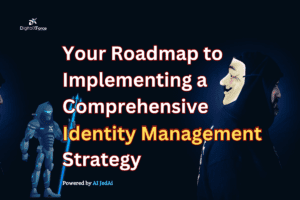
Lalit Ahluwalia is committed to redefining the future of cybersecurity by helping large and small-scale businesses prioritize digital trust. Here, Lalit explores a 10-step roadmap for implementing a comprehensive identity management strategy as part of a robust cybersecurity program in your organization. He believes that adopting a combination of Zero Trust and Digital Trust approaches will set you up for success and secure your IT infrastructure against identity theft.

In the ever-evolving world of digital security, one thing remains constant: the importance of a robust identity management strategy. You’ve heard about the critical role it plays in safeguarding your organization’s sensitive data, but where do you start, and how can you ensure success?
In this article, I’ll guide you through the process, sharing insights from recent research, to help you implement a comprehensive identity management strategy that works.
Understanding the Landscape
Before we dive into the nitty-gritty of implementing an identity management strategy, let’s take a moment to understand the current digital security landscape. Research by Cybersecurity Ventures predicts that cybercrime will cost the world $10.5 trillion annually by 2025. In this environment, identity management is your first line of defense.
Steps to Implement an Effective Identity Management Strategy
The following steps will help you implement an identity management strategy that works:
Step 1. Assess Your Needs
Your journey to a successful identity management strategy begins with a thorough assessment of your organization’s needs. Recent findings from the Identity Defined Security Alliance (IDSA) indicate that the first step to success is understanding your unique requirements. This assessment should encompass not only your current security measures but also future scalability and compliance requirements.
Ask yourself questions like:
- What data and resources do you need to protect?
- How many users and devices will need access?
- What regulatory requirements must you adhere to?
By comprehensively understanding your organization’s unique identity management needs, you set the stage for a strategy that’s tailor-made for success.
Step 2. Select the Right Technology
Choosing the right technology is pivotal. A mismatched solution can result in a security gap, leaving your organization vulnerable. The market offers a plethora of options, from Single Sign-On (SSO) solutions to Multi-Factor Authentication (MFA) tools.
Consider recent reports, such as the one by Gartner, which lists the top identity management vendors, and compare their features to your needs. Ensure that the technology you select aligns with your organization’s requirements.
Step 3. Develop a Clear Policy Framework
Now that you have the right technology in place, the next step is to develop a clear policy framework. Recent research in the National Center for Education Statistics emphasizes the importance of having well-defined policies that guide the usage of your identity management systems.
Your policy framework should cover:
- Access control rules
- Password policies
- User provisioning and de-provisioning procedures
- Data classification guidelines
Clear policies provide the foundation for a secure and organized identity management strategy.
Step 4. Implement User Training
No matter how robust your technology and policies are, your success hinges on user compliance. Recent incidents, such as the rise in phishing attacks, underscore the importance of user training.
Invest in training programs that teach your employees about the dangers of sharing credentials, recognizing phishing attempts, and following best practices in managing their digital identities.
Step 5. Regular Audits and Monitoring
Recent research from the Identity Theft Resource Center highlights the value of continuous monitoring and audits. Regularly inspect your identity management system to ensure that it’s working effectively and remains aligned with your organization’s evolving needs.
- Are there any anomalies in user access?
- Is there a spike in failed login attempts?
- Are there signs of unusual user behavior?
Regular audits and monitoring help you stay one step ahead of potential threats.
Step 6. Adapt and Evolve
In the dynamic realm of cybersecurity, standing still is not an option. Data breaches like the one experienced by the Colonial Pipeline Company underscore the urgency of staying adaptable. Keep a watchful eye on evolving threats and technologies. Adjust your identity management strategy as needed to address new challenges.
Step 7. Embrace Zero Trust and Digital Trust
Advancements in the field of identity management advocate the adoption of a combination of Zero Trust and Digital Trust approaches. Zero Trust operates on the principle that trust should not be granted automatically, even to users inside the network.
Implementing Zero Trust and Digital Trust means verifying identities continuously and rigorously, even for users within your organization. This combined approach is gaining popularity due to its effectiveness in countering emerging threats.
Step 8. Enforce Compliance
As new regulations like GDPR and CCPA come into play, the increase in company sanctions emphasizes the importance of compliance in identity management. Non-compliance can result in hefty fines and damage to your organization’s reputation.
Implement controls and procedures to ensure that your identity management strategy aligns with relevant regulations. Regularly update your strategy to remain compliant as new laws emerge.
Step 9. Emphasize Data Encryption
With data breaches making headlines daily, it’s essential to safeguard sensitive information through robust encryption. Cases, such as the breach at Capital One, highlight the need for encryption to protect data both in transit and at rest.
Ensure that your identity management strategy includes strong encryption measures to safeguard user data, whether it’s stored on servers or transmitted over networks.
Step 10. Seek Expert Guidance
Implementing a comprehensive identity management strategy can be a daunting task. A survey by PwC indicates that many organizations prefer to seek expert guidance. Consulting with professionals who specialize in identity management can provide invaluable insights and save you time and resources.
Conclusion
Implementing a successful identity management strategy is crucial in today’s cybersecurity landscape. Recent research, news articles, and expert opinions all point to the significance of this process.
By assessing your needs, selecting the right technology, developing clear policies, investing in user training, regularly auditing and monitoring, adapting to new challenges, embracing a combined approach of Zero Trust and digital Trust, enforcing compliance, emphasizing data encryption, and seeking expert guidance, you can create a robust and effective identity management strategy that safeguards your organization’s digital assets.
Remember, your organization’s security is a dynamic journey, and staying ahead of emerging threats is the key to success.
Related Posts
Enabling Data Protection From a Compliance to “Digital Trust” Perspective
Digital Trust vs Zero Trust: Redefining Cybersecurity for the Future
 "Digital trust" cybersecurity solutions enabling automated, real-time risk mitigation are crucial for protecting organizations in today's threat landscape.
"Digital trust" cybersecurity solutions enabling automated, real-time risk mitigation are crucial for protecting organizations in today's threat landscape.